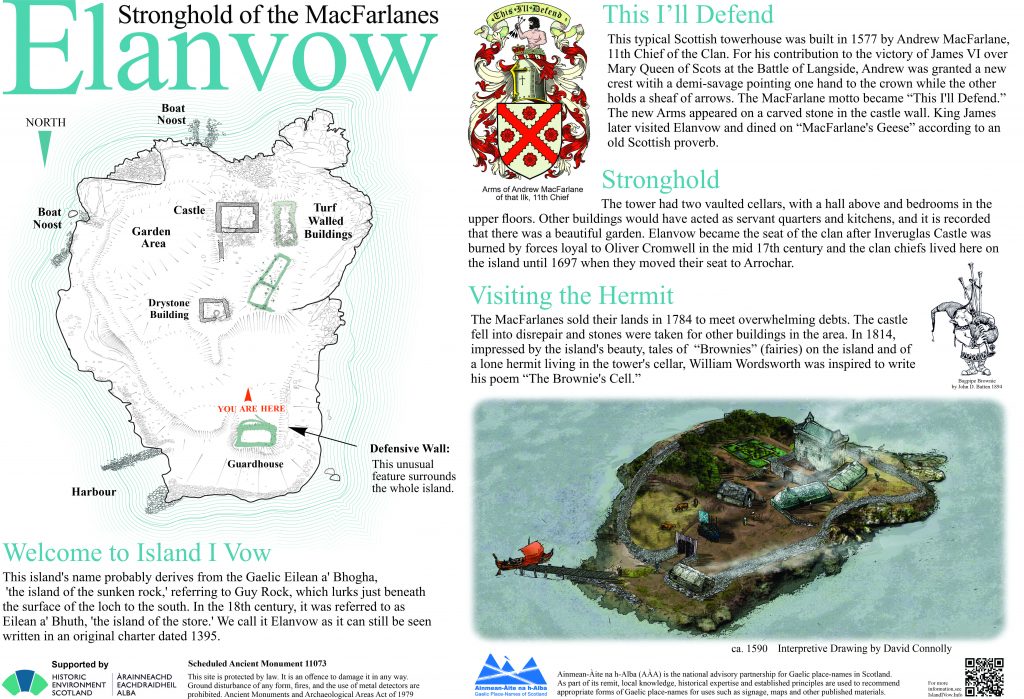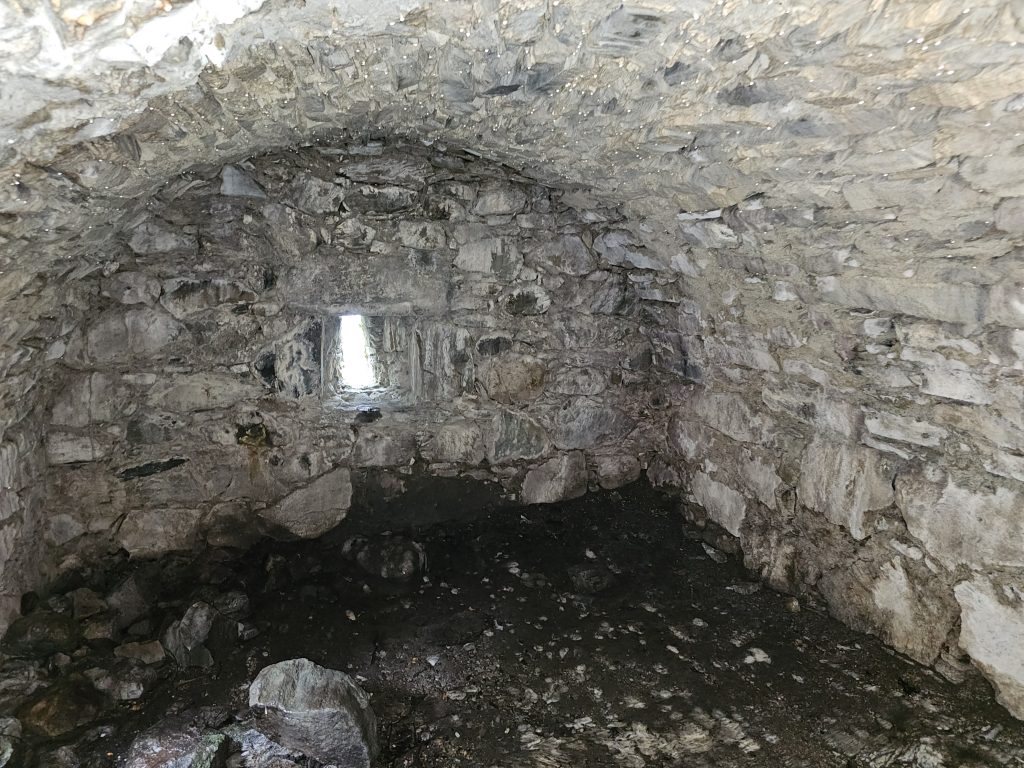Welcome visitors from the Clan MacFarlane 2025 Annual World Gathering (Scroll down for more!)

Welcome to Island I Vow!
Welcome to visitors from the Clan MacFarlane 2025 Annual World Gathering! The QR code in the lower right of the sign on Island I Vow will link visitors to this site and evergreen information about this important Scheduled Ancient Monument!
We make regular annual trips to maintain the site with our next trip scheduled for September 2025. Although Historic Environment Scotland often sponsors our major projects, your donations support the maintenance on Island I Vow and other Macfarlane preservation work! For more information see Elanvow.Org, EllanVhow.org, or IslandIVow.org.
Historic Environment Scotland (HES) has specified tree work to protect our Inveruglas Isle castle for future generations and have sponsored work for Inveruglas Isle for September 2025! Please visit the link below and give us your feedback on the proposed tree work. For more information and/or to support this effort, please see The Inveruglas Isle Project.
We hope you find the sign and supporting information useful and that it inspires all to appreciate and protect this historical site. Island I Vow, including the island and all structures on it, is protected by the Scottish Government as Scheduled Ancient Monument 11073.
How did the island get its name?
…Malicious Water Sprites?
The earliest writing of the island’s name can still be seen in an existing charter dated 1395 at the Royal Faculty of Procurators in Glasgow. There it is written “Elanvow”. Dr. Eila Williamson of the University of Glasgow has confirmed that transcription. Walter Macfarlane, 20th chief of the Clan MacFarlane, wrote that an earlier charter, dated circa 1215, also referred to Elanvow. The name “Macfarlane” (“MacParlane”) did not exist until after 1263 so this island was called Elanvow even before the name Macfarlane first existed!

Elan, Ellan, Eilean are all variants of Gaelic words for “island”. The island has generally been called Island Vow in many different ways.
There are several interpretations suggesting that Vow may come from Gaelic or even Norse (Viking) roots. In Gaelic, “bh” is pronounced as “v” and there are several Gaelic words that may be the basis for Vow. In about 1590, Timothy Pont made maps of the area and wrote “yl: na Vow” where “yl:” is interpreted as eilean or island and, again, “Vow” appears literally.

Dr. Simon Taylor of the University of Glasgow in “PLACE-NAMES OF THE PARISH OF ARROCHAR”, p11, suggests that Vow may likely come from the same roots as “bode” or “foreboding” and the Gaelic/ancient root of the name is likely Eilean a’ Bhogha. Bhogha refers here to the swell of water warning of a sunken rock. a malicious water sprite, or other nautical hazard and there are similar references to “Vows” elsewhere. Recent research discovered that there is, in fact, a large rock just feet below the loch surface to the south of Island I Vow AND the island was used in nautical charts to warn sailors to navigate around it! Dr. Jacob King of Ainmean-Àite na h-Alba also reviewed and supported the position that Bhogha was the likely root of Vow in the island’s older name. See this site for more.
We don’t know what the loch levels are today, but go out (carefully) on the rock outcrops at the south end of the island. Although the loch level is higher now than in earlier centuries and Guy Rock is fully submerged, you can sometimes see a swell of water rise up over the submerged rocked at the south of the island and it almost looks like you just saw the tail of a mermaid slipping over into the water. We saw this clearly with the low water levels in May 2025.
No Cows involved!
In the mid 20th century, some modern authors speculated that the island might have been named The Island of the Cow, since the later Macfarlanes were noted for cattle rustling and since bó or bhó (lenited) is Gaelic for cow. Even though that romantic notion was popular, it is documented that the name “Vow” was given to the island before Macfarlanes even existed and we are told sternly that the Gaelic grammar would be incorrect as Eilean a’ bhó when we ask native Gaelic speakers. Elanvow did NOT get its name for Island of the Cow. The author who originally proposed this has also retracted that speculation.
Many Variations Over Time
It is also documented that the island was referred to as Eilean Ur (the New Island) for a while after the castle was built there in 1577 and also Eilean a’ Bhùth (Island of the Store or Shop) in the 18th century after the Clan chief had moved to the mainland. See this site for a list of many of the names used for Island I Vow over the centuries.
Write it like it sounds!
The island’s name was often written as “Vow” even by educated people who spoke Gaelic. The 20th Clan chief, Walter, wrote “vow” in his notes even though he knew Gaelic, for example. However, if the person writing the island’s name did not know Gaelic, they would tend to write the name based on the way it sounded. To hear how a native Gaelic speaker would say Eilean a’ Bhogha and Eilean a’ Bhùth, please click the links below. Which would you write as “Vow” with a “w” sound at the end?
Eilean a’ Bhogha
Eilean a’ Bhùth
Even Sir Walter Scott wrote of Island I Vow
In his book “The Monastery”, Sir Walter Scott wrote of the visit of King James VI to the Island of “Inch Tavoe”. “Inch” or Gaelic “Innis” means “island” which leads this to translate as “Island ta voe”. Scott also writes of Invanhoe, where latter ends in a “long o” sound and this may further suggest that Vow was pronounced with a “long o” sound … as in Eilean a’ Bhogha. (Remember that “bh” is pronounced like “v” in Gaelic.)
Macfarlane Arms
The Andrew of that Ilk, 11th Chief of the Clan Macfarlane, built the castle here in 1577. It is recorded that the Macfarlane arms were carved into a stone built into the wall of the castle. This included the newly awarded motto, This I’ll Defend, with the demi-savage holding a sheath of arrows and pointing with his left hand to The Crown. See our interpretation of Andrew’s arms on the sign. This interpretation was reviewed and approved by the Lord Lyon and Lyon Court. The carved stone has never been found and may yet lie buried in the ruble of the castle tower!
Where’s the dungeon?
BE SURE to go in the “the Dungeon” while visiting Island I Vow! There is plenty of room inside this arched cellar even though it is a little tricky to get in through the small door. Be Careful!
We believe there were two arched cellars supporting the castle with a stairway on the northeast (in the indentation that looks like a fireplace with a small window in it). This is consistent with the construction that can be seen at other similar castles.

Wordsworth and The Hermit
William Wordsworth’s The Brownie’s Cell
“In this tour, my wife and her sister Sara were my companions. The account of the “Brownie’s Cell” and the Brownies was given me by a man we met with on the banks of Loch Lomond, a little above Tarbert, and in front of a huge mass of rock, by the side of which, we were told, preachings were often held in the open air. The place is quite a solitude, and the surrounding scenery very striking.” (William Wordsworth)
Although his facts took some romantic “poetic license” with the facts, William Wordsworth was inspired by Island I Vow’s beauty and its stories of Macfarlanes, fairies and hermits. From this inspiration, he wrote the poem, “The Brownie’s Cell”.
The Brownie’s Cell
MEMORIALS OF A TOUR IN SCOTLAND 1814
SUGGESTED BY A BEAUTIFUL RUIN UPON ONE OF THE ISLANDS OF LOCH LOMOND, A PLACE CHOSEN FOR THE RETREAT OF A SOLITARY INDIVIDUAL, FROM WHOM THIS HABITATION ACQUIRED THE NAME OF THE BROWNIE’S CELL.
I To barren heath, bleak moor, and quaking fen,
Or depth of labyrinthine glen;
Or into trackless forest set
With trees, whose lofty umbrage met;
World-wearied Men withdrew of yore;
(Penance their trust, and prayer their store;)
And in the wilderness were bound
To such apartments as they found,
Or with a new ambition raised;
That God might suitably be praised.
II High lodged the ‘Warrior’, like a bird of prey;
Or where broad waters round him lay:
But this wild Ruin is no ghost
Of his devices–buried, lost!
Within this little lonely isle
There stood a consecrated Pile;
Where tapers burned, and mass was sung,
For them whose timid Spirits clung
To mortal succour, though the tomb
Had fixed, for ever fixed, their doom!
III Upon those servants of another world
When madding Power her bolts had hurled,
Their habitation shook;–it fell,
And perished, save one narrow cell;
Whither, at length, a Wretch retired
Who neither grovelled nor aspired:
He, struggling in the net of pride,
The future scorned, the past defied;
Still tempering, from the unguilty forge
Of vain conceit, an iron scourge!
IV Proud Remnant was he of a fearless Race,
Who stood and flourished face to face
With their perennial hills;–but Crime,
Hastening the stern decrees of Time,
Brought low a Power, which from its home
Burst, when repose grew wearisome;
And, taking impulse from the sword,
And, mocking its own plighted word,
Had found, in ravage widely dealt,
Its warfare’s bourn, its travel’s belt!
V All, all were dispossessed, save him whose smile
Shot lightning through this lonely Isle!
No right had he but what he made
To this small spot, his leafy shade;
But the ground lay within that ring
To which he only dared to cling;
Renouncing here, as worse than dead,
The craven few who bowed the head
Beneath the change; who heard a claim
How loud! yet lived in peace with shame.
VI From year to year this shaggy Mortal went
(So seemed it) down a strange descent:
Till they, who saw his outward frame,
Fixed on him an unhallowed name;
Him, free from all malicious taint,
And guiding, like the Patmos Saint,
A pen unwearied–to indite,
In his lone Isle, the dreams of night;
Impassioned dreams, that strove to span
The faded glories of his Clan!
VII Suns that through blood their western harbour sought,
And stars that in their courses fought;
Towers rent, winds combating with woods,
Lands deluged by unbridled floods;
And beast and bird that from the spell
Of sleep took import terrible;–
These types mysterious (if the show
Of battle and the routed foe
Had failed) would furnish an array
Of matter for the dawning day!
VIII How disappeared He?–ask the newt and toad,
Inheritors of his abode;
The otter crouching undisturbed,
In her dank cleft;–but be thou curbed,
O froward Fancy! ‘mid a scene
Of aspect winning and serene;
For those offensive creatures shun
The inquisition of the sun!
And in this region flowers delight,
And all is lovely to the sight.
IX Spring finds not here a melancholy breast,
When she applies her annual test
To dead and living; when her breath
Quickens, as now, the withered heath;–
Nor flaunting Summer–when he throws
His soul into the briar-rose;
Or calls the lily from her sleep
Prolonged beneath the bordering deep;
Nor Autumn, when the viewless wren
Is warbling near the BROWNIE’S Den.
X Wild Relique! beauteous as the chosen spot
In Nysa’s isle, the embellished grot;
Whither, by care of Libyan Jove,
(High Servant of paternal Love)
Young Bacchus was conveyed–to lie
Safe from his step-dame Rhea’s eye;
Where bud, and bloom, and fruitage, glowed,
Close-crowding round the infant-god;
All colours,–and the liveliest streak
A foil to his celestial cheek!